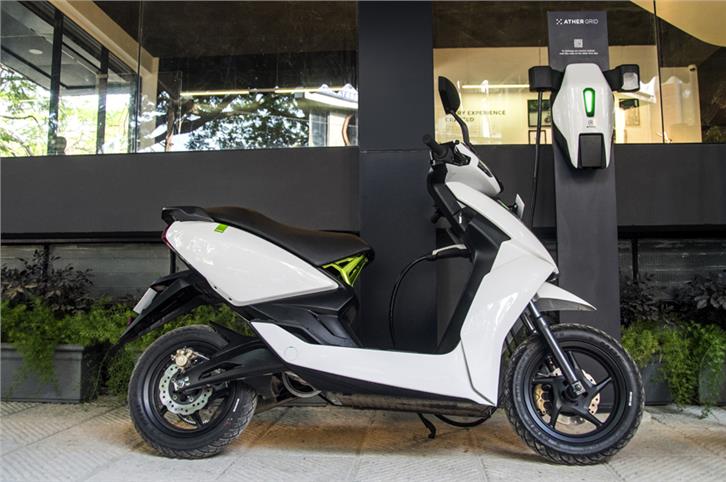Blog: The smart automobile is here
Exciting? Yes. But should you also be worried?
Published on Jun 10, 2018 07:00:00 AM
18,821 Views
Follow us on
Smart mobility is a term that’s being tossed around liberally these days. I just had my first taste of a genuinely smart and connected product when we rode the Ather 450. Many positive things stood out about this machine, but the one thing that I haven’t been able to get over is the ‘smart’ aspect of things.
Data love
To give you a brief introduction, the Ather 340 and 450 scooters come with a number of data farming sensors, including a gyroscope, GPS and even a six-axis IMU, which is the same bit of technology that enables advanced traction control and cornering ABS functions in high-end motorcycles. At the moment, the IMU aids the Ather’s self-cancelling indicators, but the scooter has neither traction control nor ABS – standard or cornering. Although, I imagine it won’t be the hardest thing for the company to incorporate those kinds of technologies in their future products.
But I digress, because, in addition to these sensors, the Athers also have a full-time GSM connection that’s paid for as part of a monthly subscription package. This not only enables the scooter to receive over-the-air updates from the company, but also allows the scooter to relay vast amounts of data back to Ather.
I know where you went last summer... and every other time!
What kind of data are we talking about? Well, our ride through Bengaluru city concluded at the AtherSpace showroom/experience centre. Here, the officials were able to show me the exact route I’d taken to get there. Multiple squiggle lines up and down the same stretch of road reminded me that this was where we took some passing shots for the video review. In effect, Ather knew exactly where I was, when I was there and how many times I went past the same stretch of road. But wait, there’s more.

The next data sheet I was shown was an unusual circular structure with hundreds of lines sticking out in every direction, some longer than others. This, I discovered, was a detailed map of my riding style. Every upward facing line was representative of each time and how much I opened the accelerator. Downward lines represented every squeeze of the brakes, the length of the line indicating how hard the levers were pulled. And finally, the lines to the left and right indicated how far I leaned the scooter over to either side.
To put it simply, Ather knew every single thing about how I rode their scooter that day.
Makes you think, doesn’t it? Ather says it isn’t really interested in your personal data, and is only using it to monitor the health of each scooter, and to develop future updates more efficiently. None of this data can be accessed from the scooter and can only be viewed at the AtherSpace facility. But this shouldn’t come as shock, as most of us already (and quite willingly) share silly amounts of our information with the likes of Google, Apple and Facebook, to name a few.
Those of you who, like me, feel squeamish at the thought of minimal privacy can opt out via an Incognito mode. However, you’ve got to remember to do so every day, as the mode resets itself every 24 hours. Thankfully, Ather is open to making this a one-time thing and can easily do so via a simple update.
Sweet surrender
And that’s where the pleasure of this system comes in. Ather can effectively keep updating your scooter with OTA updates in time. This could range from anything like simple bug fixes to far more complex processes. For example, if the company figures out a way to tweak its battery management system in a way that improves the performance and/or efficiency of the existing hardware, it could simply blast that update out to all the scooters on the road. If it chooses to do so, there’s no reason why your existing scooter won’t get even more advanced as time passes.
In a similar vein, the electric drivetrain requires very little maintenance, and for the few consumables like brake pads, belts, etc., it's possible that the scooter will be able to tell you when a replacement is due, rather than you waiting for a predetermined due date.

The same applies to the costs of running. Ather’s monthly Rs 700 subscription package not only covers all normal service costs, but will include all costs incurred while charging the scooter. So while charging at the AtherGrid (the company’s public fast charging network) will be free to subscribers, the company will also reimburse you for the costs incurred while charging from a private electric connection. How does this work? The scooter is smart enough to know where it is being charged and how much electricity it has consumed. It relays this information back to Ather, and the company will refund the money to you via an e-wallet. Astonishing!
This is only the start
You can call me a technophobe (and I most certainly am), but this is the direction we’re headed in. As with all our gadgets, more and more vehicles are going to become smart and connected. True privacy will eventually fade into fable that will make future generations exclaim in disbelief.
While that Black Mirror-esque way of life is thankfully still some time away, there are already some implications to consider for now. One that comes to mind is that this sort of technology is an insurance provider’s wildest dream. Even at today’s level of tech, it would be almost too easy to identify the location of an accident, the speed of impact and even any evasive manoeuvres attempted. I won’t be surprised to see insurance policies of the future rewarding those who agree to share this information with lower premiums, if not insisting on it outright.
This is but a single example and I’m sure there are far more conceivable scenarios, where, in some areas this kind of tech is good, and in others, not so much. Ultimately, the only thing that’s genuinely going to safeguard customer privacy is a well thought-out set of government regulations. Until then, relish the simple joys of your ‘dumb’ automobile.



Comments
Member Login
Personal Details
No comments yet. Be the first to comment.